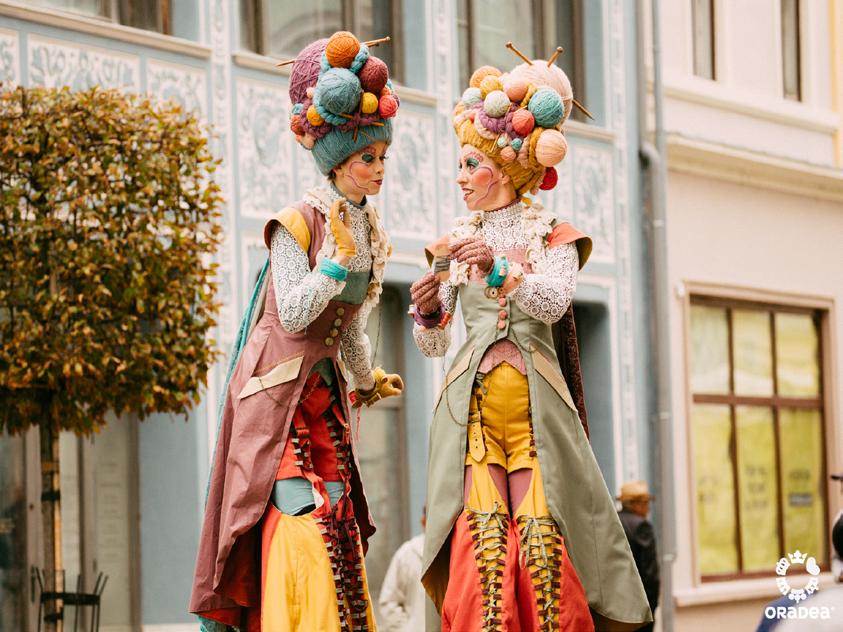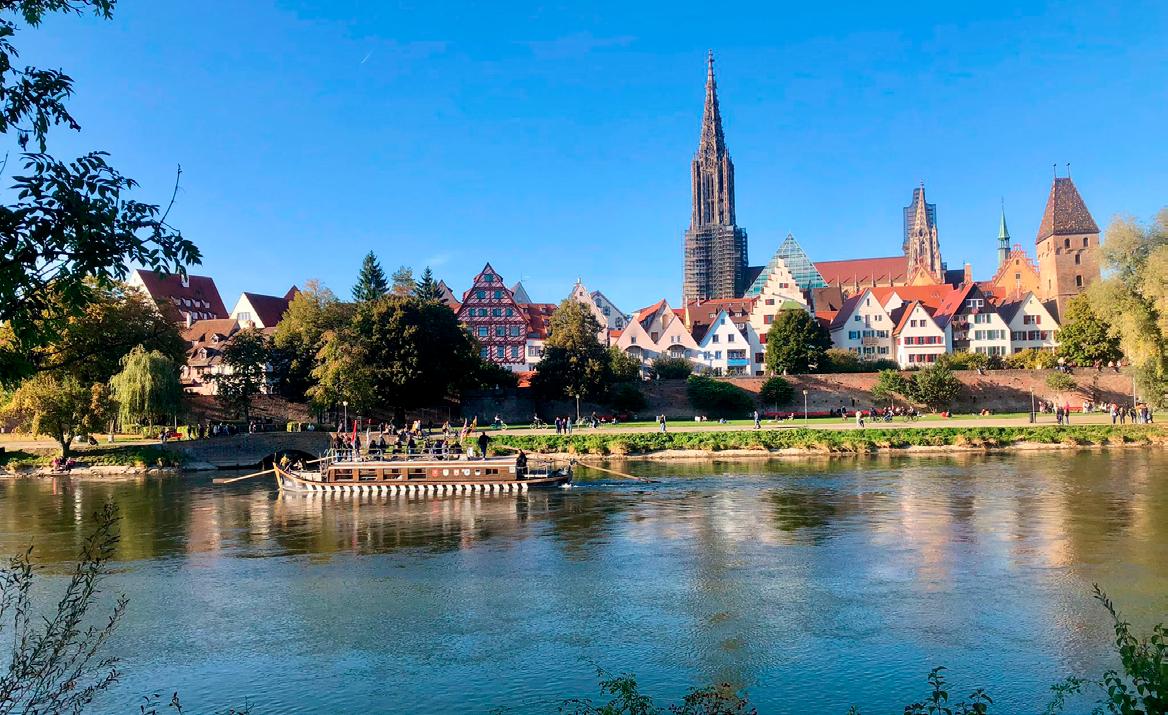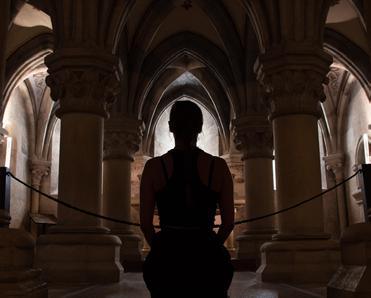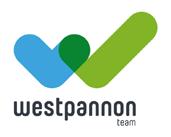









Starting in Linz (Austria), the story is told until Timişoara in Romania, passing Slovakia, Hungary, Croatia, and Serbia and two more European capitals of culture: Pécs and Novi Sad. Hungary is in the centre of the journey with all the expansions, divisions, and upheavals seen by this region and caused by religions, ideologies, or claims to power that have repeatedly divided and unified Europe. The experience is one of disruption, which has resulted in enormous richness in art, culture, religion, tradition and language. Danubian Europe has become a funnel of influences and a region that suffered from wars, expulsions, and annexations, but became a melting pot of cultural processes that underlies its fascination.

Since Roman antiquity, the Danube has been the most important transport route in Central Europe and a link between a region closely intertwined in history and culture.
For more than 500 years, the Habsburg Danube Monarchy served as a connecting link - the “road of emperors and kings”, along which the cultural and historical relics of the turbulent common history of transnational “Danube Europe” can be discovered. From its turbulent history to its technological innovations and creativity, its cultural diversity transforms it into a unique, world-class destination.
• THE LAST DANUBE’S HEARTLAND
In the beginning, was the Danube – thus begins this story, echoing the biblical account of the creation. Water and nature have defined the landscape. But mankind has changed it, “cultivated” it, and, in the end, abused it. This is the scenario of this story, which takes travellers from the triangle formed by the countries of Hungary, Croatia and Serbia to the grandiose estuary flowing into the Black Sea. It explores the fascination of the river landscape, but also the many problematic changes caused by human intervention. The last section of the Danube forms the largest surviving natural wetland in Europe. Experiencing the Danube here means reconnecting with nature in its most primal form, and with our very selves. Herein lies the fascination of the “last Danube”.
Iron Gate © Public Enterprise Djerdap National Park

With thousands of animal and plant species, impressive forests, and wild waters - the Danube offers an extraordinary and incomparable natural environment. The perfect route for all nature-loving outdoor fans.

Undoubtedly, the story of the Danube can’t be told without its food. Have a look! - DANUBEPARKS Cookbook „One river, ten countries, countless flavours “ ”Nature’s Havens on the Danube “(book, 2nd edition)
TIKfest – Festival of living history and gastronomy

In 2021, the Roman Limes was declared UNESCO World Heritage from Germany to Slovakia. Where the river once marked the Roman border, traces of human settlement go back 70,000 years. Following the Roman Trail along the Danube opens up an astonishing perspective of achievements in logistics, architecture and culture. Roman culture was neither domineering nor exclusive; it was open to mixing with other cultures, to progress and friendship across its own borders. In this respect, the trail shows that “borders” are transitory and ultimately remain fluid. The Danube as a fluid border was therefore always a connecting force as well.
Embark on a journey through time & admire the stunning structures along the Danube that have been preserved from the Roman era. Throughout this trip, you will visit some special places that are guaranteed to become the next travel hot spot!

Cultural, gastronomic, and touristic offers along with the Roman Emperors and Danube Wine Route, presented in a 360° virtual experience.

This trail along the upper half of the Danube follows a history that starts out from prehistoric traces, continues through the Middle Ages and the Ba roque era to the 19th and 20th centuries and shows that everything originated along the Danube that is, or at least reflects, the very essence of Europe. The journey launches out in Ulm and continues via Regensburg, Linz, Krems and Vienna to Hungary, Romania, Serbia and back via Croatia to Murska Sobota in Slovenia. Nowhere else have so many ethnic groups lived together, and still do, whose reciprocal fertilisation, even if under compulsion, bequeathed a cultural richness that has made the Danube into a treasure trove of human culture and ways of life. The culture, art, architecture and music of the region reflect this best.

Attention, all art and culture lovers!
In our “On the edges of the Danube Monarchy” travel series, we will be in Serbia and Slavonia, eastern Croatia. You will meet interesting people, get a deep and authentic insight into the country’s history and current situation. You can enjoy Art Nouveau buildings, find the oldest flute in the world and also sit in a lively café and talk about literature.
World Art Nouveau Day in the Vasile Alecsandri
An augmented reality tool developed to plunge tourists visiting the main square of Oradea into the time and atmosphere of the beginning of 20th century.
Novi Sad is the capital of autonomous province Vojvodina within Serbia, while Slavonia is a region in Croatia.
Apart from military and religious movements, the Danube region has always been attracted and dynamised by trade. Trade has inspired the cultural and regional exchange of goods and people in the Danube region: raw materials have been exploited or processed there, markets developed, businesses founded, and people brought together … The Danube is one of Europe’s oldest trade routes, providing ample material for cross-border stories, encounters, and experiences. Merchants have brought cultures together and have had a formative influence on them. This trail starts in Ulm and leads down to Romania.
The Danube is one of the oldest trading routes in Europe. Even during the darkest ages of history, the Danube was used by traders to transport their goods into foreign lands. Find out how the Danube influenced trade and experience Then and Now.

Interactive city tour on trade -Ulmer Geld regiert die Welt
TAKE A JOURNEY: CROATIAN DANUBETHE DANUBE KINGDOM OF WINES AND NATURAL PEARLS
 Ulm © Donaubüro gemeinnützige GmbH
Ulm © Donaubüro gemeinnützige GmbH
This Danube trail stretches from Hungary through Slovenia, Croatia, Serbia, and Bulgaria to Romania. It presents us with impressive, shocking, sometimes heart-breaking witnesses of a past; witnesses reflecting the people’s pursuit for dominance and exclusiveness, tolerance or intolerance in the realm of faith. Religions and their adherents have no doubt done a lot of good, but also caused a lot of grief. Catholicism, Protestantism, Orthodoxy, Judaism and Islam – all these religions solidified in the Danube region in such a way that not only individuals, ethnic groups and nations identified with them, but that entire states and territories split up and repeatedly reunited because of them. Any journey along the Danube is a journey to a great number of – often forgotten – customs, a journey of self-discovery.
The Danube region has been home to many diverse religions over the years - a place of dialogue, of compassion, and tolerance. Reconnect with your inner self and experience the many spiritual sites along the Danube.

–
FROM BRATISLAVA TO SZOMBATHELY (SAVARIA) – Velo Martini- a cycling pilgrimage along the Via Sancti Martini is guided by a digital tool available at the cultural route’s website. It not only supports cyclists with a detailed itinerary including suggested cultural sites and nice stopovers to rest, but also provides a handful “spiritual provisions” for the soul along the journey.
SLOVENIA GREEN PANNONIAN ROUTE – is a 3-stage cycling itinerary in the total length of approximately 120 km, which stops in 3 green-certified destinations in northeastern corner of Slovenia tucked in the Heart of Europe and offers journey away from crowds and embrace rich cultural heritage, pristine nature and rich culinary traditions.

- Discover the Jewish heritage in Slovenia with the app - Self-guiding mobile application presenting Jewish tangible and intangible cultural heritage of Maribor, Murska Sobota and Lendava destinations.
Jeruzalem © Public Institute for Tourism, Culture and Sport Ormož






The aim of the project is to travel the six newly developed trails in the Danube region in a sustainable way. To do so, a Sustainable Tourism Mobility Plan (STOMP) was created for each of the trails. A STOMP consists of a status quo analysis of sustainable travel options along the trails as well as within the individual destina tions. This analysis also leads to recommendations for improve ment.
Furthermore, a database was created in which the researched links of all STOMPs are documented according to countries, destinations and means of transport to quickly find the information searched for.
Additionally, Travel Time Maps with motivating, sustainable con nections were created for different destinations to inspire travel lers to use public transport.
These project results are a valuable output to support mobility stations and tourism centres in providing tour ists with a variety of options for sustainable travel, thus motivating them to travel sustainably along the trails. You can find the Travel Time Maps and more information following the website.
Product Clubs are networks of local stakeholders linking Transdanube Travel Stories with Experiences developed within the Project framework. During the project’s lifetime, the Partners first identified and mapped potential stakeholders on the local level – initiating platform for mutual cooperation and hospital ity. Following, a serious of on-line and in-person meetings and trainings were organized, at least per partner, highlighting Stories and Experiences they want further jointly to work on. Consequently, 16 Product Clubs are formed along the Danube, in Germany, Austria, Slovenia, Hungary, Croatia, Serbia, Bulgaria and Romania. Let your journey start!
Every story needs someone to tell it. The more vocal story-teller is, the story gains complexity and relevance to the ears of a listener. Transdanube Travel Stories have found its story-tellers in 20 guides from across the Danube Region, during a three-day long Winter School for Guides, organized in Moson magyaróvár from May 4th-6th, 2022.
Prof. Gabor Bodis from Budapest Metropolitan University, Prof. Goran Petkovic from Belgrade Faculty of Economics and Ms. Jasmina Beljin Iskrin, head of the Tourism Organization of Sremski Karlovci in Serbia, shared with participants their insights, thoughts and ideas towards new approaches in tour ism with the focus Danube Attractions and Stories. Following, the participants were invited to split in two groups and think of a guided tour in nearby city of Győr. Great experience!
The main objective of the training was to introduce the importance of sustainable mobility with a focus on the tourism sector. The participants from six different Danube countries learned about the basics of mobility management (illustrated with best solutions) and the main functions of regional mobility centres. They had also the chance to learn about local/regional challenges and good practices in sustainable transport in each of the participating countries. The participants could obtain an in-depth understanding of the functions and services of a mobility centre and the skills and competencies needed to become a mobility manager. Besides learning theoretical knowledge, they were also practical parts were the participants could experience sustainable means of transport. Therefore, they went on a canoeing trip on the Danube and had a travel chal lenge to Bratislava by train or bike. Moreover, the participants had a city travel challenge in Bratislava, where they had to find differ ent sights in the city by using sustainable mobility. The training enabled the participants to gain knowledge in the field of sustain able tourism mobility and more so to act as a multiplier in their home countries and for their region.
The new THE PEP Partnership Sustainable Tourism Mobility was officially announced in the course of the 5th High Level Meeting of THE PEP in Vienna, on May 18th 2021. It aims at bringing together the relevant stakeholders responsible for mobility, climate action and tourism in a unique pan-European cooperation platform. The Austrian Federal Ministry of Climate Action, Environment, Energy, Mobility, Innovation and Technology and the Austrian Federal Ministry of Labour and Economy took the lead in this new THE PEP Partnership on Sustainable Tourism Mobility. In the meantime, 12 countries as well as UNWTO, UNECE, WHO and ECF are involved in the elaboration of the main output of the partnership: a toolbox on sustainable tourism mobility support ing the responsible national authorities to push sustainable mobility in tourism based on existing good practices from the partner countries.
You would like to join THE PEP Partnership Sustainable Tourism Mobility? Get in touch with Andreas Friedwagner, a.friedwagner@verracon.at
Environment Agency Austria
Danube Office Ulm/Neu-Ulm, Germany –representing Danube.Pearls Network


WDG Danube Upper Austria Tourism Ltd. –representing Danube.Pearls Network
Tourism Board Linz, Austria – representing the Route of Emperors and Kings
West Pannon Regional and Economic Development Public Nonprofit Ltd., Hungary –representing Via Sancti Martini

Institute for Culture, Tourism and Sport Murska Sobota, Slovenia – representing European Route of Jewish Heritage
Croatian Association for Tourism and Rural Development “The Village Membership Club”– representing Iter Vitis Route
Association for Promoting Tourism in Oradea and its Region, Romania – representing Réseau Art Nouveau Network

Danube Competence Center (DCC), Serbia–representing the Roman Emperors and Danube Wine Route


DANUBEPARKS – Danube River Network of Protected Areas, Austria
8 Associated Strategic Partners supporting the successful implementation of the project
The project is initiated and supported by
The project is part of THE PEP (Transport-HealthEnvironment Pan-European Programme)

Lead Partner – Environment Agency Austria Agnes KURZWEIL – agnes.kurzweil@umweltbundesamt.at
Project coordination
Christina NARVAL – c.narval@verracon.at
Quality Management
Andreas FRIEDWAGNER – a.friedwagner@verracon.at Website http://www.interreg-danube.eu/approved-projects/ transdanube-travel-stories